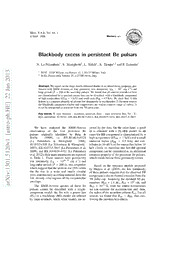
Blackbody excess in persistent Be pulsars PDF
Preview Blackbody excess in persistent Be pulsars
Mem.S.A.It.Vol.84,1 (cid:13)c SAIt 2008 Memoriedella Blackbody excess in persistent Be pulsars N. LaPalombara1,S. Mereghetti1,L. Sidoli1,A. Tiengo1,2 andP. Esposito1 3 1 INAF-IASFMilano,viaBassini15,I–20133Milano,Italy 1 2 IUSS,PiazzadellaVittoria15,I–27100Pavia,Italy 0 2 n Abstract.Wereportonthemainresultsobtainedthankstoanobservationcampaign,per- a formed with XMM–Newton, of four persistent, low–luminosity (L ∼ 1034 erg s−1) and J X long–period (P > 200s)Beaccretingpulsars.Wefound thatallsourcesconsidered here 2 arecharacterizedbyaspectralexcessthatcanbedescribed withablackbody component 2 ofhightemperature(kT >1keV)andsmallarea(R <0.5km).Weshowthat:1)this BB BB featureisacommonpropertyofseverallow–luminosityX–raybinaries;2)formostsources ] E theblackbodyparameters(radiusandtemperature)arewithinanarrowrangeofvalues;3) itcanbeinterpretedasemissionfromtheNSpolarcaps. H h. Keywords.X–rays:binaries–accretion,accretiondisks–stars:emissionline,Be–X– p rays:individual:4U0352+309,RXJ0146.9+6121,RXJ0440.9+4431,RXJ1037.5–5647 - o r t We have analyzed the XMM–Newton jected by the data. On the other hand, a good s observations of the four persistent Be fit is obtained with a PL+BB model. In all a [ pulsars originally identified by Reig & casestheBB componentischaracterizedbya 1 Roche (1999), i.e. RXJ0146.9+6121 hightemperature(kTBB > 1keV)andasmall (La Palombara & Mereghetti 2006), emission radius (R < 0.5 km), and con- v BB 4U0352+309 (La Palombara & Mereghetti tributesto30–40%ofthesourcefluxbelow10 0 2007),RXJ1037.5-5647(La Palombaraet al. keV (Table 1): therefore this hot–BB spectral 2 1 2009), and RXJ0440.9+4431 (La Palombara componentcanbeconsideredasanadditional 5 etal.2012);theirmainparametersarereported commonpropertyofthepersistentBepulsars, . in Table 1. These sources have persistently whichstandsbesidethosepreviouslyknown. 1 low luminosity (L ∼ 1034−35 erg s−1) and 0 X 3 long pulse period(P > 200s), two properties Based on the emission models proposed 1 whichsuggestthattheneutronstar(NS)orbits by Hickox et al. (2004), the low luminosity v: the Be star in a wide and nearly circular ofthesepulsarssuggeststhattheobservedBB orbit,continuouslyaccretingmaterialfromthe i componentisduetothermalemissionfromthe X low–densityouterregionsof thecircumstellar NS polar cap. Assuming the standard NS pa- r envelope. rameters M = 1.4 M , R = 106 cm, and a NS ⊙ NS The XMM–Newton spectra of these Be B = 1012 G, from the source luminosities NS pulsars cannot be described with a single- we can estimate the accretion rate and, then, component model: the fits with a power–law theradiusoftheaccretioncolumnR .Forall col (PL) or a blackbody (BB) model are affected sources we found that R ∼ R , thus con- col BB by large residuals, while other models are re- firmingtheprevioushypothesis. 2 LaPalombara:BlackbodyexcessinpersistentBe/NSbinarypulsars 1036 3388 Blackbody temperature (keV)Blackbody temperature (keV)Blackbody temperature (keV)Blackbody temperature (keV)Blackbody temperature (keV)Blackbody temperature (keV)Blackbody temperature (keV)Blackbody temperature (keV)Blackbody temperature (keV)Blackbody temperature (keV)Blackbody temperature (keV) 121212121212121212121212121212 11003345 Log(L) (2−10 keV, erg s)Log(L) (2−10 keV, erg s)−1−1XX 3366 3344 000000000000000...............555555555555555 1033 555555555555555000000000000000 111111111111111000000000000000000000000000000 222222222222222000000000000000000000000000000 555555555555555000000000000000000000000000000 111111111111111000000000000000000000000000000000000000000000 2222000000000000 00..0011 00..11 11 1100 110000 11000000 110044 BBBBBBBBBBBlllllllllllaaaaaaaaaaaccccccccccckkkkkkkkkkkbbbbbbbbbbbooooooooooodddddddddddyyyyyyyyyyy rrrrrrrrrrraaaaaaaaaaadddddddddddiiiiiiiiiiiuuuuuuuuuuusssssssssss (((((((((((mmmmmmmmmmm))))))))))) PPuullssee PPeerriioodd ((ss)) Fig.1. Left: Best–fit values for R and kT of the low–luminosity high–mass X–ray binaries with a BB BB hot–BBspectralcomponent(differentsymbolsrefertodifferentsources);thecontinuouslinesconnectthe BB parameters corresponding tofour different levels of L (in ergs−1). Right: X–ray luminosity (inthe X 2–10 keV energy range) of the pulsars withadetected thermal excess asa function of the pulse period; filledcirclesrefertothehot–BBpulsars,emptysquarestothesoft–excesssources. Table1.MainparametersofthepersistentBeX–raybinaries Source 4U0352+309 RXJ0146.9+6121 RXJ1037.5-5647 RXJ0440.9+4431 OpticalSpectralType 09.5IIIe B0IIIe B0III-Ve B0.2Ve Distance(kpc) ≃1 ≃2.5 ≃5 ≃3.3 PulsePeriod(s) 839.3 1396.1 853.4 204.98 L (0.3–10keV,ergs−1) 1.4×1035 1.5×1034 1.2×1034 8.3×1034 X L (0.3–10keV,ergs−1) 5.5×1034 3.6×1033 5.0×1033 2.9×1034 BB L /L (%) 39 24 42 35 BB X T (keV) 1.42±0.03 1.11±0.06 1.26+0.16 1.34±0.04 BB −0.09 R (m) 361±3 140±15 128+13 273±16 BB −21 R (m) ∼330 ∼230 ∼200 ∼320 col A spectral feature similar to the hot BB we report the luminosity and pulse period of ofthepersistentBepulsarshasbeenobserved bothtypesofpulsars.Ontheaverage,thehot– also in other low–luminosity (L ≤ 1036 erg BB pulsarsarecharacterizedbythelowestlu- X s−1)high–massX–raybinaries(LaPalombara minosities and the longest periods; their hot– et al. 2012). In Fig. 1 (left panel) we report BB spectral component is a common feature the best–fitradiusandtemperaturefortheBB which separates them from all the other pul- componentofthesesources:itshowsthat,for sars, stronglysuggestingthatthey forma dis- all the sources, kT > 0.5 keV and R < 2 tinctandwell–definedclassof binarypulsars. BB BB km; moreover,forthe less luminosity sources References (L ∼ 1034 erg s−1), the spectral parameters X are within a narrow range of values (kTBB ∼ Hickox, R. C., Narayan, R., and Kallman, T., 1–2 keV and RBB < 200 m), with a 20–40% 2004,ApJ,614,881 contributionoftheblackbodycomponent. La Palombara, N. and Mereghetti, S., 2006, In contrast to this sample of sources, sev- A&A,455,283 eral pulsars are characterized by a soft ex- La Palombara, N. and Mereghetti, S., 2007, cess, since the fit of this component with a A&A,474,137 thermalemission modelprovideslow temper- LaPalombara,N.etal.,2009,A&A,505,947 atures(kT < 0.5keV)andlargeemittingre- LaPalombara,N.etal.,2012,A&A,539,A82 SE gions(R > 100km).In Fig. 1 (rightpanel) Reig,P.&Roche,P.,1999,MNRAS,306,100 SE
